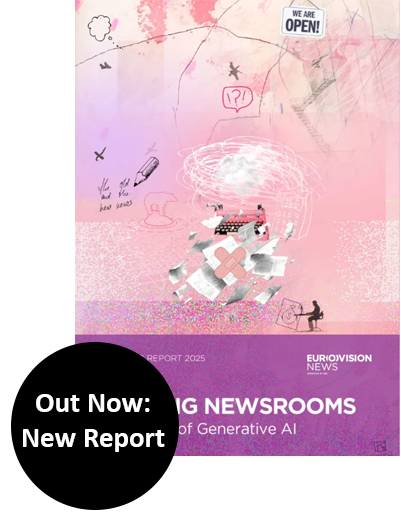LSE-Professor Charlie Beckett, founder and director of the JournalismAI project, talks about what AI means for journalism, how to tell advice from rubbish, and how the news industry adjusts to the new challenges.

Medieninsider: Since the launch of ChatGPT, new AI applications relevant to journalism have been announced almost every day. Which one intrigues you the most?
Charlie Beckett: A small newsroom in Malawi that is participating in our AI course for small newsrooms, recently built a generative AI-based tool that is practically a whole toolbox, It can be used to simplify newsroom workflows. The idea is to quickly process information and cast it into formats, a kind of super-efficient editorial manager. It’s not one of those sensational applications that help discover deep fakes or unearth the next Watergate as an investigative tool. But I think it’s great: an African newsroom that quickly develops something that makes day-to-day operations easier. I think the immediate future lies in these more mechanical applications. That often gets lost in the media hype. People would rather discuss topics like killer robots.
Do you think small newsrooms will benefit most from AI, or will the big players be the winners once again?
The answer is: I don’t know! So far, when it comes to innovation, large newsrooms have benefited the most because they can invest more. But if small newsrooms can find a few tools to help them automate newsletters or analyze data for an investigative project, for example, it can help them tremendously. A ten percent gain in efficiency can be an existential question for them. For local newsrooms AI could prove to be a bridge technology. At least that’s what I hear in conversations.
Because they can do more with fewer people? There is this example from Sweden of a tool that automatically evaluates real estate prices; it has been successful generating subscriptions, because readers love that kind of stuff – just like weather and traffic reports.
At least, that’s what editors at small newsrooms hope. They say they could use AI to produce at least sufficient content to justify the existence of their brand. Reporters could then focus on researching real local stories. We’ll see if that happens. But AI will definitely shape the industry at least as much as online journalism and the rise of social media have.
AI seems to unleash enthusiasm and a spirit of experimentation in the industry, unlike back in the early days of online journalism, when many were sceptical.
The speed of the development is almost breath-taking. In the beginning, we looked at artificially generated images and thought, well, that looks a bit wobbly. Three months later, there were already impressively realistic images. We’re moving through this hype cycle right now. No matter which newsroom in the world I talk to everyone is at least playing around with AI; by the end of the year at the latest, many will have implemented something.
But you say it’s too early to make predictions?
We’re seeing an extremely fluid development right now. Advertisers don’t yet know what to do, and in the relationship between platform groups and publishers, a lot is out in the open again. In fact, I’ve never experienced anything like this before. It’s clear to everyone that we’re facing a big change.
But isn’t it risky to just wait, and see?
Automation is still very unstable. Setting up new processes at the current level would be like building a house on a volcano. The right process is: let employees experiment, learn, and definitely think about potential impacts. If you’re asking me now, what are the ten tools I need to know, that’s the wrong question.
That’s exactly what I wanted to ask, of course. That’s what a lot of people want to know at the moment, after all. And everyone wants to be the first to publish the ultimate AI manual for newsrooms. So, do you have to be suspicious when someone confidently claims to have solutions?
We are currently collecting who is using which tools and what experiences are being made with them. But we are not making recommendations about what is the best tool. I just spoke to the CEO of a major broadcaster. They are doing it this way: In addition to regular meetings and information sessions, they take half an hour a day to simply play around with new tools. If you’re a CEO, of course you must budget for AI. But it should be flexible.
Many newsrooms are currently establishing rules for the responsible use of AI. Bayerischer Rundfunk is one example; the person who pushed this was in one of the first cohorts of your LSE Journalism and AI Project.
Establishing rules is a good thing, but it should read at the very beginning: All this could change. It’s also important to start such a set of rules with a message of encouragement. Any CEO who immediately says we don’t do this, and we don’t do that is making a big mistake. The best guidelines are the ones that say, these are our limits, and these are the important questions we should be asking about all applications. Transparency is an important issue: who do I tell what I’m experimenting with? My supervisors, my colleagues, the users? And, of course, a general caution is in order. Currently there are swarms of company representatives out there, trying to sell you miracle tools. 90 percent of them are nonsense.
How transparent should you be to the public?
Bloomberg, for example, writes under its texts: This is 100 percent AI-generated. That’s not meant as a warning signal, but as a sign of pride. It’s meant to say: we can handle this technology; you can trust us. I think editors are a bit too worried about that. Today it doesn’t read under texts: „Some of the information came from news agencies“ or „The intern helped with the research.” Newsrooms should confidently use transparency notices to show consumers that they want to give them more value. Some brands will continue to have clickbait pages and now fill them with a lot of AI rubbish without disclosing that. But these have probably always produced a lot of garbage.
How does journalism education need to change? Should those who enter the profession because they like to write now be discouraged from doing so because AI will soon be extremely good at it?
The first thing I would say is that not much will change. The qualities and skills we foster in education are deeply human: curiosity, creativity, competencies. in the past 15 years, of course, technical skills have been added. Then again fundamental things have changed. Today, more than ever, it’s about building relationships with users, it is not just about product development. Journalism is a data-driven, structured process of information delivery. With generative AI, technology fades into the background. You don’t have to learn how to code any longer. But a key skill will be to learn how to write excellent prompts. Writing prompts will be like coding, but without the math.
Journalists may feel their core skills challenged by these AI tools, but couldn’t they be a great opportunity to democratize anything that requires language fluency? For example, my students, many of whom are not native speakers, use ChatGPT to edit their resumes.
Maybe we shouldn’t use that big word democratization, but AI could lower barriers and remove obstacles. The lines between disciplines are likely to blur. I used to need data scientists or graphic designers to do certain tasks, now I can do a lot of stuff myself with the right prompts. On the other hand, I’m sceptical. We often underestimate the ways in which inequalities and injustices persist online.
We’ve talked a lot about the opportunities of AI for journalism. What are the biggest risks?
There is, of course, the great dependence on tech companies, and the risk of discrimination. Journalism has to be fact-based and accurate, generative AI can’t deliver that to the same extent. But the biggest risk is probably that the role of the media as an intermediator will continue to dwindle. Already the Internet has weakened that role; people can go directly to those offering information. But AI that is based on language models will answer all questions without people ever encountering the source of the information. This is a massive problem for business models. What kind of regulation will be needed, what commercial agreements, what about copyright? Frankly, I’ve never seen industry executives so worried before.
This is indeed threatening.
It’s existential. First, they said, oh my God, the Internet has stolen our ad revenue. Then they said, oh my God, Twitter has taken attention away from us. And now they’re staring at this thing thinking, why in the world would anyone ever come to my website again? And they have to find an answer to that.
Do journalists have to fear for their jobs?
Media organisations won’t disappear overnight. But there will be more products that will look like good journalism. We have a toxic cocktail here that is fascinating, but also scary. This cocktail consists of uncertainty, which journalists always love. It also consists of complexity, which is exciting for all intelligent people. The third ingredient is speed, and the old rule applies here: we usually overestimate the short-term consequences and underestimate the long-term effects. Over the 15 years that I’ve been doing this, there have been people who have said, 80 percent of media brands will disappear, or 60 percent of journalists will no longer be needed or things like that. But today we have more journalism than ever before.
But the dependence on the big tech companies will grow rather than shrink.
On the one hand, yes. You definitely need friends from this tech world to help you understand these things. On the other hand, suddenly there’s new competition. Google may no longer be this great power we thought it was. New competition always opens opportunities to renegotiate your own position. The media industry must take advantage of these opportunities. I’m on shaky grounds here because the JournalismAI initiative is funded by Google. But I think neither Google nor politicians really care about how the media is doing. Probably quite a few politicians would be happy if journalism disappeared. We therefore need to redefine and communicate as an industry what the added value of journalism is for people and society – regardless of previous ideas about journalism as an institution.
Quite a few colleagues in the industry say behind closed doors, „Fortunately, I’m approaching the end of my career, the best years of journalism are behind us.“ Would you want to be a journalist again under the current conditions and perspectives?
Absolutely. It’s an empirical fact that with all the possibilities today, you can produce better journalism than ever before.
The interview was first published in German by Medieninsider on 9th September 2023 and in English on 14th September 2023.




